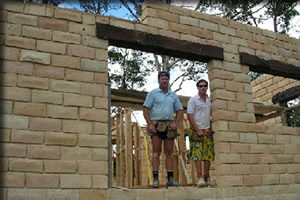A relatively new material, Timbercrete is a unique blend of cellulose, cement, sand, and binders to enhance block strength and stop excessive water penetration.
Although still an emerging technique – Timbercrete is advantageous enough that it will probably play a role in ongoing sustainable development.
The insulation value of 250mm Timbercrete walls is R1.25 which is almost double the insulation value of brick veneer and cavity brick (without added wall insulation).– Spec-net.com.au
Timbercrete is a lightweight composite masonry material invented in Australia, and is available in the form of bricks, blocks, panels and pavers. Made from excess sawmill waste from plantation timbers mixed with sand and binders such as Portland cement and a non-toxic deflocculating additive, it is cured using sun and wind and has a lower embodied energy than traditional fired bricks.
– yourhome.gov.au

- More than twice as light as clay or concrete
- Moderate thermal mass.
- Better insulator than brick, clay or concrete.
- Highly fire resistant.
- Malleable – does not shatter like brick or concrete
- Can be nailed, screwed or sawed like timber
- Very long lasting
- Can be made to resemble cobblestone, sandstone or mud brick
